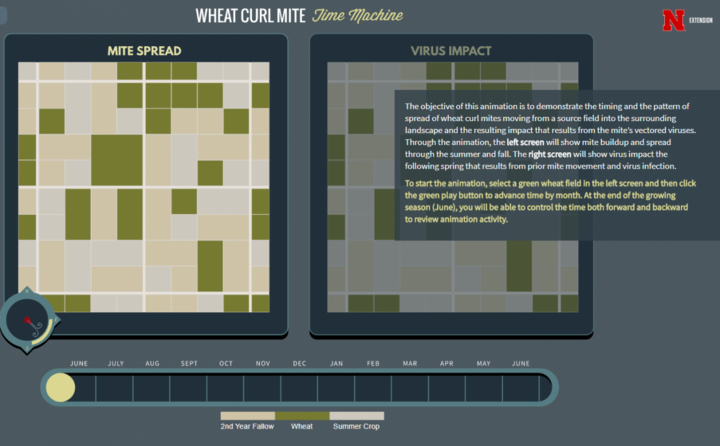Wheat streak mosaic virus (WSMV) problems have been extensive throughout the western Great Plains this year, significantly reducing the yield potential of many fields. In Nebraska, most of the serious virus problems have occurred in areas where pre-harvest hail occurred last summer. A critical factor contributing to the serious issue this year was the very warm, extended fall.
The wheat curl mite is a vector of a complex of three viruses in wheat, the most common being WSMV. Wheat infected with WSMV is characterized as being stunted with a yellowing mosaic pattern on the leaves. Head size and number of tillers is often reduced which lowers wheat yields. These viruses can only become a problem if mites survive the summer on a living bridge host and become numerous in the fall to carry the virus into the new crop wheat.
The extended fall in 2016 allowed mite populations more time to build up to greater densities and to increase movement into the new crop, thus increasing risk. In addition, the warm fall enabled greater virus replication and buildup within the infected wheat plants, increasing virus impact.
This Nebraska Extension video, produced by the Department of Entomology, describes the wheat curl mite, wheat streak mosaic virus, and how to manage both. (View larger at https://mediahub.unl.edu/media/7596)
Wheat Curl Mite Survival Across the Green Bridge
Based on field observations, approximately 90 grass species have been listed as potential hosts for the wheat curl mite. Of these hosts, wheat is considered to be the primary host as mites have demonstrated a high rate of reproduction in wheat. With the exception of wheat, corn is one of the most well-documented and tested hosts for the wheat-mite-virus complex. Mite activity and virus spread from corn to wheat has been shown to be most severe when corn maturity is delayed past wheat emergence. Early maturation of corn in most areas last year minimized this risk and limited the importance of corn as a bridge host.
If volunteer wheat is eliminated at least two weeks prior to planting wheat, serious virus problems will not develop, even if environmental conditions are quite favorable.
Pre-harvest volunteer wheat has by far the greatest risk for mite and virus development; therefore, managing this "green bridge" host is critical to reducing risks from this virus complex. It is important to identify the presence of this volunteer at harvest and focus efforts on eliminating this serious threat to avoid harvest losses. Without these sources of mites serious virus problems will not result, even if environmental conditions are quite favorable.
Pre-harvest volunteer wheat and other mite hosts must be controlled throughout the summer and should be completely controlled a minimum of two weeks prior to planting wheat. Without a green host, mites can only survive about a day and will need to find a new host to survive.
Tillage and/or herbicides can both be effective at controlling hosts. Both operations would need to be completed about a month before planting wheat to allow sufficient time for the hosts to completely dry up and cease being a suitable host.

If not adequately controlled, mite populations will continue to build throughout the fall. Mites will move from these green bridge source fields in all directions as the wind changes directions through the fall. However, studies have shown a greater potential for movement to the south and east of source fields, likely due to the prevalence of winds from the northwest in fall. (See Mite Movement Animation http://passel.unl.edu/custom/wheat-mite-visualization/.) Fields adjacent to the source fields are at greatest risk, and in many situations a gradient of movement and virus spread can be seen from these source fields. However, under serious mite/virus presence in volunteer wheat, mites and virus can spread well beyond the neighboring field.
Controlling volunteer wheat and other grass hosts is the key to managing WSMV. Some wheat varieties have some resistance to WSMV and could be used in a high-risk scenario. Wheat infected after planting in the fall will likely suffer some yield loss. Once infected, there are no other options to prevent yield loss.

